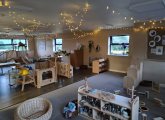“I went from banter to baskets!” says Sarah Watkins, who swapped her Year 6 class for the very different environment of Reception…
In my eight years of teaching I’ve moved from KS2 to KS1 and back again, but now for the first time I have a Reception class.
I’ve loved teaching every year group but this was a dramatic move – going from Year 6 to early years. I worried about getting my head around a new curriculum.
I worried that I would miss the banter. I worried that I wouldn’t have the infinite patience required of a Reception teacher.
The first shock to my system was physical. Muscles that I hadn’t used for years were suddenly being put into action. I was constantly bending down and moving around. Yoga classes were no longer required and my Fitbit began buzzing at 11am to tell me I had completed 10,000 steps.
There’s surely no tired like early years teacher tired.
In my first week I was covered in bruises from the tiny furniture. In addition to the impact on my body, I had to adjust my voice. What was appropriate for a Year 6 classroom was just bewildering for little ones.
Now that I was teaching in early years, I found I couldn’t throw anything away – and I was even eyeing up other people’s rubbish. I became obsessed with curtain rings, beads and wicker baskets.
Displays had been essential for my KS2 class in terms of reminding them of key strategies and celebrating their achievements, but now I had to create indoor and outdoor areas that piqued the interest of young pupils and supported their independent learning.
My husband rolled his eyes as I made playdough in five different colours and collected junk-modelling materials from the local garden centre.
Then a child in my class spent 40 minutes making a bridge for one of our story characters from said junk-modelling materials. All of the children who engaged with this challenge showed ingenuity, but this child was completely and absolutely absorbed.
I sat down next to him, fascinated to see him visibly problem solving. He was utterly delighted when he established a way to make the complex design in his head a reality.
For this child, the whole class, including me, simply disappeared. All that existed now were his tools, materials and imagination.
His perseverance was extraordinary. Eventually, he carefully ripped one final piece of masking tape and scrutinised his ‘bridge’ for a long time.
He attached the tape to a specific area and pushed it down.
A beatific smile appeared on his face and he clasped his hands in proud delight.
“There!” he said.
I think it was in this moment that I fell in love with early years.
It’s genuinely enthralling to see how young pupils can completely immerse themselves in an activity, and their excitement about learning is infectious. In the hands of a four-year-old, a cardboard box so quickly becomes a pirate ship or a zoo or a tunnel to another world.
An early years teacher with a puppet in his/her hand can inspire a hushed silence, roaring laughter or squeals of delight.
As a Reception teacher, I’ve been astonished by the rapid progress of my pupils, and teaching children to read is incredibly rewarding (even if there are frustrating stages!).
Children learn such significant skills in Reception and it’s extremely satisfying to help lay the foundations for the rest of their schooling.
One of my pupils said the other day, “Now I can cut all the way round and mine paper doesn’t rip up! I’m so proud of what I can do!” I’m not sure whose smile was bigger – mine or his.
As a newcomer to early years, I still have a lot to learn but when a class of four- and five-year-olds tell you that they love you (for the third time that morning) and beg you to read Don’t Let the Pigeon Drive the Bus (for the third time that morning), you realise that you have the best job in the world.
Sarah Watkins is a Reception teacher at Ledbury Primary School.

Enhanced provision – Set up your own story factory
Editors picks

Hygge in the early years – What it is and how to do it
Editors picks
